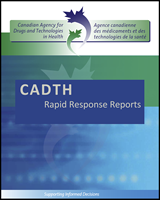APPENDIX 4Main Study Findings and Author’s Conclusions
Table A7Summary of Findings of Included Studies
View in own window
| Main Study Findings | Author’s Conclusions |
|---|
| Systematic review |
|---|
| Liu, 20149 |
|---|
Preventive studies (n=16):
4 types of ES devices were identified: conventional surface electrodes (10 studies); custom-made garment with built-in electrodes (one study); electrical current delivered through a sacral anterior nerve root stimulator (SARS) implant (2 studies); and electrical current delivered via implanted intramuscular electrodes (3 studies). Of 11 studies examining dynamic effect of ES, 8 studies demonstrated a reduction of pressure under the ischial tuberosities; 3 of 5 studies which measured local tissue oxygenation or blood flow reported an increase in regional tissue oxygenation or blood flow during the stimulation, and 2 studies reported an increase of tissue oxygenation in some participants (unclear if observed differences reached statistical significance). Of 5 studies examining long-term effects of ES, 4 studies demonstrated positive changes including reduced seating pressure or incidence of PrUs, increased muscle thickness, ischial tissue oxygenation, and sitting tolerance; one study reported no change in gluteal thickness or pressure distribution after a 12-week follow-up Of 4 studies which reported on adverse events (two studies delivered ES using surface electrodes and two studies sued a SARS implant), no adverse events were experienced by the participants.
|
“The methodological quality of the studies was poor, in particular for prevention studies. A significant effect of ES on enhancement of PU healing is shown in limited Grade I [strong] evidence. The great variability in ES parameters, stimulating locations, and outcome measure leads to an inability to advocate any one standard approach for PU therapy or prevention.” (p.703)
|
| Randomized controlled trials |
|---|
| Dutra, 201510 |
|---|
| Incidence of PrUs
Mean number of dressing changes per body region
Total number of dressing changes during the study period
Reasons for dressing changes
|
|
ES = electrical stimulation; HD = hydrocolloid dressing; PF = polyurethane film;
Table A8Summary of Recommendations in Included Guidelines
View in own window
| Findings and Recommendations | Grade/Strength of Recommendation |
|---|
| Haesler (Ed.), 201411 – National Pressure Ulcer Advisory Panel (NPUAP) European Pressure Ulcer Advisory Panel (EPUAP) and Pan Pacific Pressure Injury Alliance (PPPIA) |
|---|
Microclimate control
Consider the need for additional features such as ability to control moisture and temperature when selecting a support surface or support surface cover. Do not apply heating devices (e.g., hot water bottles, heating pads, built-in bed warmers) directly on skin surfaces or pressure ulcers.
Prophylactic dressings
Consider applying a polyurethane foam dressing to bony prominences (e.g., heels, sacrum) for the prevention of pressure ulcers in anatomical areas frequently subjected to friction and shear. When selecting a prophylactic dressing consider: ability of the dressing to manage microclimate; ease of application and removal; ability to regularly assess the skin; anatomical location where the dressing will be applied; and the correct dressing size.
Continue to use all other preventive measures necessary when using prophylactic dressings. Assess the skin for signs of pressure ulcer development at each dressing change or at least daily, and confirm the appropriateness of the current prophylactic dressing regimen. Replace the prophylactic dressing if it becomes damaged, displaced, loosened or excessively moist.
Fabrics and textiles
Consider using silk-like fabrics rather than cotton or cotton-blend fabrics to reduce shear and friction.
Electrical Stimulation of the Muscles
Consider the use of electrical stimulation for anatomical locations at risk of pressure ulcer development in spinal cord injury patients.
| Microclimate control
Strength of Evidence = C; Strength of Recommendation = Weak positive recommendation (probably do it) Strength of Evidence = C; Strength of Recommendation = Weak positive recommendation (probably do it)
Prophylactic dressings
Strength of Evidence = B; Strength of Recommendation = Weak positive recommendation (probably do it) Strength of Evidence = C; Strength of Recommendation = Weak positive recommendation (probably do it) Strength of Evidence = C; Strength of Recommendation = Weak positive recommendation (probably do it) Strength of Evidence = C; Strength of Recommendation = Weak positive recommendation (probably do it) Strength of Evidence = C; Strength of Recommendation = Strong positive recommendation (definitely do it)
Fabrics and textiles
Strength of Evidence = B; Strength of Recommendation = Weak positive recommendation (probably do it)
Electrical Stimulation of the Muscles
Strength of Evidence = C; Strength of Recommendation = No specific recommendation
|
Note: A = the recommendation is supported by direct scientific evidence from properly designed and implemented controlled trials on pressure ulcers in humans (or humans at risk for pressure ulcers), providing statistical results that consistently support the recommendation (Level 1 studies required); B = the recommendation is supported by direct scientific evidence from properly designed and implemented clinical series on pressure ulcers in humans (or humans at risk for pressure ulcers) providing statistical results that consistently support the recommendation. (Level 2, 3, 4, 5 studies); C = the recommendation is supported by indirect evidence (e.g., studies in healthy humans, humans with other types of chronic wounds, animal models) and/or expert opinion.

